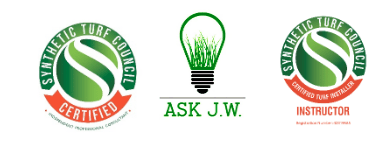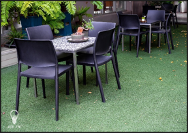COVID-19 has brought hardship upon establishments that serve the public. Restaurants have been hit the hardest due to government officials shutting them down. Many of them have had no choice but to close indefinitely. Those that have managed to stay afloat have had to create COVID-safe spaces to accommodate restaurant-goers in order to survive. Synthetic turf has been a key material in allowing these restaurant owners to move their dining outside. This month, Ask JW will provide valuable information for anyone who is choosing to temporarily install synthetic turf for outdoor dining services.
Restaurants around the globe are using all types of spaces in order to create functional outdoor dining areas. One important factor that restaurant owners need to consider is that the surface they choose for these dining areas must be clean in order to protect the health and safety of diners. It is crucial to research your city and state’s public health code when you are planning to move your dining outdoors, especially if you are planning to use propane to heat the areas.
Synthetic turf has become the #1 choice for restaurant owners searching for a surface that will beautify their new outdoor dining experience. Most have placed synthetic turf in existing parking stalls and/or parking lots. Existing planters can also be used for additional seating.
If you have decided to utilize synthetic turf for your outdoor dining surface, you will need to understand a few details that may help your installation, including preventing accidents or injuries.
Fire Rated?
Some cities and states require materials to pass E-108 testing. These test methods measure the surface spread of flame and the ability of the synthetic turf to resist fire penetration under the conditions of exposure. Synthetic Grass Warehouse carries many synthetic turf products that pass E-108 testing. Please contact your local SGW facility for more information.
Matting
In the synthetic turf industry, the “matting” of turf blades is something you want to prevent. The prevention of matting can be accomplished by placing infill between the blades to keep turf fibers upright. If you want to avoid placing infill granules for outdoor dining areas, I recommend using high-traffic turf with a low pile height, putting green turf, or just let it become matted. Yes, I said “let it become matted”. Matting is not necessarily a bad thing if the entire area matts equally. Matting also prevents chairs and tables from settling into the fibers, which may make chairs more difficult to move in and out. Keeping fibers upright in outdoor dining areas may be too difficult to realistically maintain, especially if you don’t want to place turf infill. So, I say, “let it become matted.”
ADA Transitions – Outdoor Dining
Creating and maintaining proper transitions at all areas that will be accessible is not only needed but is required by the ADA (Americans with Disabilities Act). Throwing down some turf and ignoring crucial ADA requirements and specifications in your installation can be costly, especially when you must remove the entire installation due to half of an inch.
The Americans with Disabilities Act (ADA) defines a “trip hazard” as any vertical change of ¼ inch or more at any joint or crack. If you lay the turf on the ground without a transition edge, it will create a trip hazard. The ADA demands strict compliance, and trip hazards represent a legal liability to the synthetic turf contractor who ignores ADA specifications and requirements. ADA accessibility where synthetic turf is installed must allow for wheelchairs to glide easily on and off of the turf, and it must enable braces and other accessible equipment to be used. The ADA requires the top of synthetic grass backing to be installed no more than ½ inch below the walking surface.
Synthetic turf that is too thick, too cushioned, or too loose impairs accessibility, especially wheelchair maneuvering. Synthetic turf must be securely attached so that it does not shift or buckle against wheeled traffic.
Exposed edges must have trim on the entire length of the exposed edge and must be fastened to the floor to prevent curling or trip hazards. Trim transitions must meet specifications for changes in level, including requirements for beveled edges when the height exceeds ¼ inch. The maximum height is ½ inch unless you design wider transition materials.
I came across this newly-placed synthetic turf area at a mall that was set up for outside dining. As you can see by the red arrows, this installation created a 360-degree tripping hazard. The far right picture above shows delamination due to foot traffic lifting the edge. This installation poses injury risk.
Heavy Traffic Transitions
When placing synthetic turf in areas with heavy foot traffic, I recommend designing transitions that are of everlasting quality. Some transition materials take a beating due to the amount of weight it takes on. I recommend using a transition edge that will stand the test of the seasons. Most plastic and rubber transitions, when used outside, tend to break down due to thermal expansion and contraction. If you are going to use metal, I recommend using one that will not rust. Since each installation is different from the next, a taller pile height may require wider and taller transitions due to the distance you must maintain for the ADA specifications.
ADA Transitions & Infill Placement
Synthetic turf infill plays an important role in establishing ADA requirements and specifications. This will prevent trip hazards and allow accessibility for wheelchairs. If you choose to go with an infilled turf for your outdoor dining area, you will need to check and replace infill levels periodically.
Cleaning & Disinfecting
Even though your outdoor dining area may be temporary, we now understand that maintaining health codes and transitions are crucial in keeping the flooring safe. Now we must maintain its cleanliness and ensure that whatever synthetic turf you have placed is well taken care of and is kept clean and bacteria-free. Remember, COVID-19 is the reason that these temporary outdoor dining areas are being constructed. For this reason, we must clean and disinfect the synthetic turf to remove any bacteria or contaminants that may be settling deep into the fibers. SGW now carries the only EPA-registered synthetic turf disinfectant on the market today. For more information regarding SGW turf disinfectant, please contact my Ask JW hotline at (888) 846-3598.


For more information regarding head seams or would like to schedule a training or webinar, please contact J.W. at askjw@sgwcorp.com or call (888) 846-3598.
Suggestions for the use of ASK JW installation techniques are solely at the end users’ discretion; however, the user should determine suitability for the intended use by his/her own evaluation. Because the use of the materials is beyond our control, neither ASK JW nor SGW shall be liable for the outcome of any use of said materials, including any injury, loss, or damage, direct or consequential, arising out of the use or inability to use these techniques and products.










































